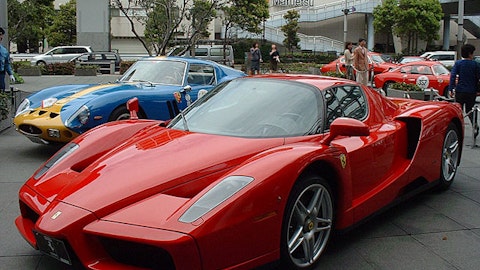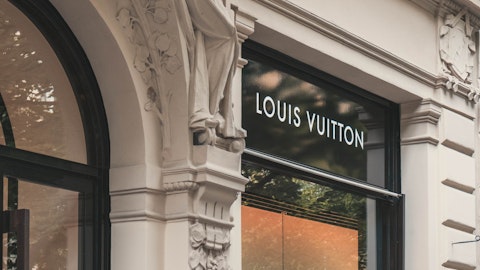Operator: And the next question comes from the line of Stephen Reitman from Societe Generale.
Stephen Reitman: A question first of all on the guidance for 2023. Just with simple maths, it seems to be that after a 28% margin, adjusted operating margin in the first 9 months of the year, if we take the lower end or for the 26.5% — at least 26.5% or more, that suggests the margin could be as low as 22% in the fourth quarter, which seems very, very low compared to the momentum you’ve shown. And the kind of — maybe the sort of currency adjusted underlying margin of 29.4% that you showed in the third quarter for FX impacts and hedges. So if you could maybe talk about the headwinds that you’re anticipating in the fourth quarter. Obviously, we know this is a very conservative guidance you always give. And my second question is about Formula 1.
And could you update us on the status of how you are with have you fully now replaced all the sponsorship that you lost, obviously Mission Winnow and Velas? Now you have a full roster, including your main sponsor. I saw you took on Virtual Gaming World, but does that now mean now you’re fully — your car is fully livery and you have everything you need?
Benedetto Vigna: I take the second one. Stephen, thanks for the question. And then I will ask Antonio to comment on the first one. So let me say in this way. In the last 3 years, we have been able to lower depend sponsorship wise. We have been able to lower the dependence on, let me say, on a single sponsor. Okay. So if in the past this single sponsor was accounting for more than 60% of revenues, and now if I take the biggest sponsor in our basket it’s no more than 13%, 14%. So I would say that on the sponsorship wise, we have been able to enlarge the sponsor base by lowering also the dependence on a big one. So this is the answer to the Formula 1. And then Antonio.
Antonio Piccon: And Stephen, I think the reasoning is the one I try and explain in words in my speech. If you look at Q4, what is different compared to the previous quarter is in terms of volumes, lower allocation to the fourth quarter. It’s already design that way since the beginning of the year. Secondly, we have a specificity in terms of the overall seasonality of the spending, particularly R&D expenses to the P&L for raising. If we normalize for that, even at the EBITDA margin level, we get much more in line with the rest of the year. In addition, if you go to the EBIT margin level, then you should take into consideration that DNA are going to grow in the Q4. And this is due to 2 elements, one is the start of production of a couple of new models. And the second one is our some projects that we are going to start depreciating. That are more related to our infrastructure development of the sales. And thanks for complements on being conservative.
Operator: And the next question comes from the line of Giulio Pescatore from BNP Paribas.
Giulio Pescatore: And first one, I want to come back on a comment made by one of your competitors. I know you don’t comment on competitors, but it was striking because they were calling out weakness in luxury cars demand, especially in North America. And what they said, it seemed very stark contrast with whatever you’re saying today. So I’m not asking you to comment on competition, but just what do you think is making the difference here? Why your demand is so much healthier and resilient than some of your peers? Then second one, just a clarification. The track cars you launched, those don’t count towards the 15 models expected to be launched by 2026 and the 4 models for this year? Just a clarification on that. And then very last one, the 499P.
I mean, can you give us an indication on volumes and price and when do you expect deliveries to happen? And is there any reason to expect these cars to be less profitable than the limited edition ones you have launched in the past?
Benedetto Vigna: So I start from — so these 2 cars, they count in the 15 models also because despite the fact that they look like something else, I mean we had to put a lot of resources in engineering, in managing this product. So they count. The 296 Challenge is only ICE, is not hybrid well, well — but there has been a lot of work done by our colleague in the engineering in the factory to make it happen. The 499P Modificata, it’s a car that comes in few 10s of it. And it is a car that, as I said, will offer our gentleman driver the possibility to drive the same experience of our, let me say, pilot that won a few months ago in Le Mans. And I would say that I want to share with you this comment that I heard for me gentlemen drivers.
Last I heard in Mugello last week. No, they were very happy to have the possibility to test themselves on a racetrack with a car that, by the way, does not have even the balance of performance. So if, let’s say, our drivers, when they are racing in the World Endurance Championship, there is a balance of performance. So they cannot go faster than they would like. The gentlemen drivers, since it is in its own, it can do even faster, so he can enjoy even more the speed of this car. And then the first question, why we believe we are resilient? I would like to answer the question — the answer, sorry, in 2 parts. I think when we’re talking about Ferrari car, we are talking about an ultra-luxury car that is also addressing maybe demographics that is different from other brands.





